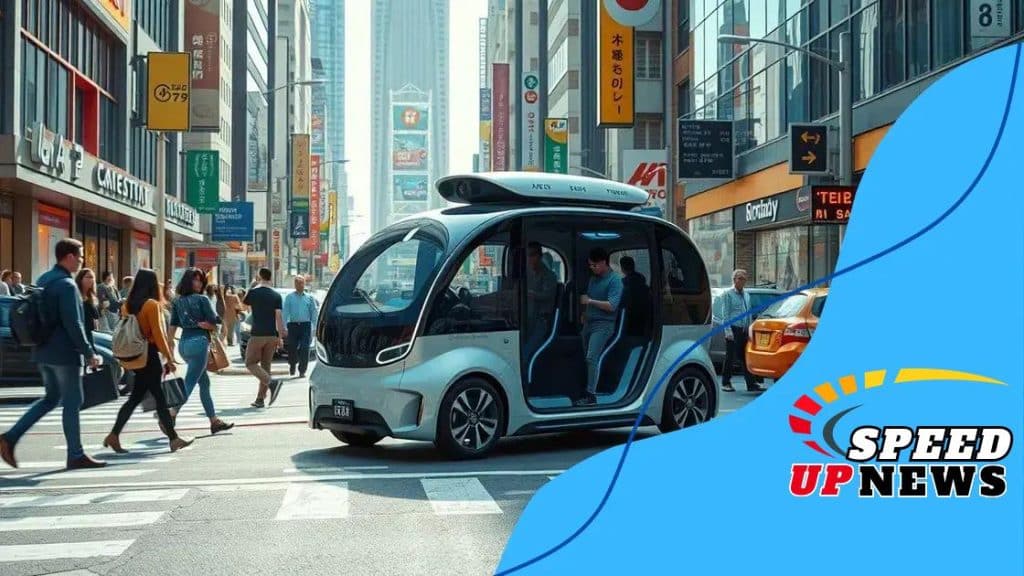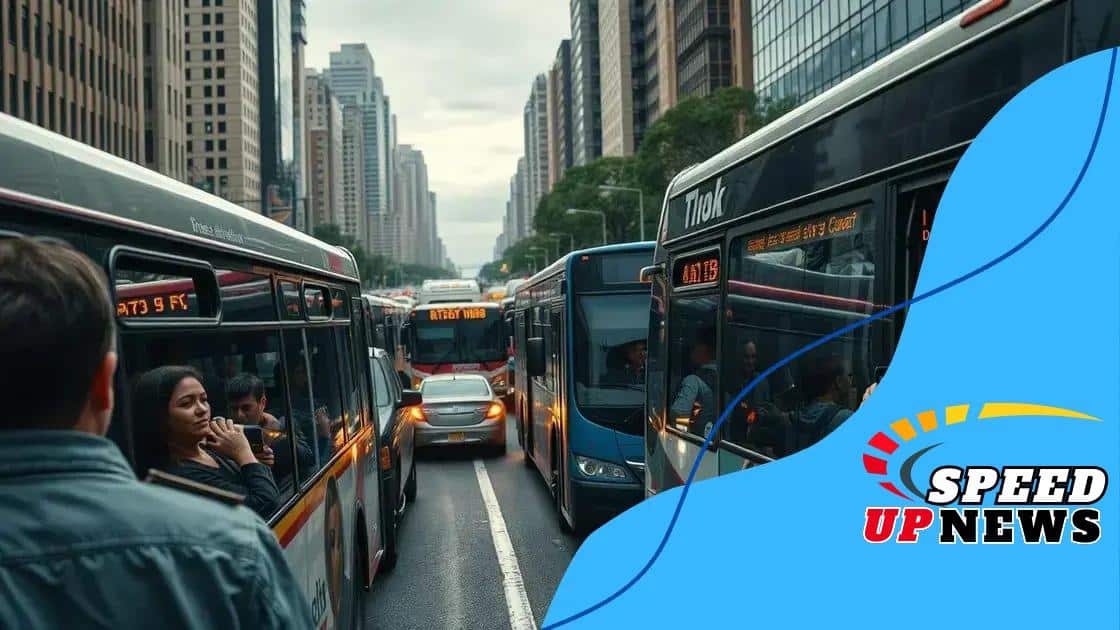Autonomous vehicles’ impact on public transport systems

Autonomous vehicles significantly impact public transport systems by enhancing safety, increasing operational efficiency, and providing flexible services, while also presenting challenges like integration with current infrastructure and securing funding.
Autonomous vehicles’ impact on public transport systems is a topic that stirs up plenty of discussions. Have you ever wondered how these self-driving cars could change your daily commute? Let’s dive into the implications.
Understanding autonomous vehicles and their technology
Understanding autonomous vehicles and their technology is essential in today’s rapidly evolving transportation landscape. These vehicles are equipped with advanced systems that allow them to operate without human intervention. To grasp their impact, we must look deeper into the technology and principles that guide these innovations.
Core Technologies Behind Autonomous Vehicles
At the heart of autonomous vehicles lie several key technologies. These technologies work together to enable self-driving capabilities. Some of the primary components include:
- LiDAR: Light detection and ranging technology that creates 3D maps of the environment.
- Radar: Utilizes radio waves to detect objects and assess their speed and distance.
- Cameras: Provide visual input to interpret signals, obstacles, and lane markings.
- Software Algorithms: Process data from various sensors and make real-time driving decisions.
These systems communicate with one another to form a comprehensive understanding of the vehicle’s surroundings. For example, LiDAR and radar serve as eyes, whereas software algorithms act as the brain. The seamless interaction between them allows vehicles to navigate safely through complex environments.
Types of Autonomous Vehicles
There are different levels of automation in vehicles, classified from Level 0 to Level 5. Each level represents the degree of control assumed by the vehicle compared to a human driver. At Level 0, the driver has full control, while Level 5 indicates full autonomy without any human input.
- Level 1: Driver-assist features like adaptive cruise control.
- Level 2: Partial automation where the vehicle can control steering and acceleration.
- Level 3: Conditional automation, allowing the vehicle to handle driving under certain conditions.
- Level 4: High automation, with vehicles capable of driving independently in specific environments.
- Level 5: Fully autonomous vehicles that can operate anywhere without human intervention.
As these vehicles evolve, their integration into public transport systems becomes more feasible. The growing adoption of autonomous technology could revolutionize how we think about commuting and traffic management.
Overall, understanding the core technologies and classifications of autonomous vehicles is crucial for appreciating their potential. As they continue to advance, the future of transportation looks promising, with new opportunities for efficiency and safety at the forefront.
Benefits of autonomous vehicles for public transport
The benefits of autonomous vehicles for public transport systems are numerous and far-reaching. These vehicles can greatly enhance efficiency and convenience while providing a safer travel experience.
Increased Accessibility
One significant advantage of autonomous vehicles is their potential to improve accessibility for all individuals, including those with disabilities. By offering reliable and on-demand transport services, these vehicles can bridge the gaps in traditional transport systems. Imagine a world where everyone, regardless of their mobility challenges, can travel independently.
- On-demand services cater to individual needs.
- Flexible routing allows for easier access to various destinations.
- Reduced waiting times enhance user satisfaction.
This enhanced access can encourage more people to use public transport instead of personal vehicles, reducing road congestion and emissions.
Cost Efficiency
Another notable benefit is the cost efficiency that autonomous vehicles can bring to public transport systems. By minimizing operational costs, cities can allocate resources more effectively. Automated vehicles can operate longer hours and handle routine maintenance, which reduces the need for extensive staff. This can ultimately lead to lower fares for users.
Furthermore, the reduction in accidents due to the advanced safety features inherent in autonomous technology can lead to decreased insurance costs for transport providers. This cost-saving can be passed on to passengers, encouraging more extensive use of public transportation.
Environmental Impact
Autonomous vehicles also have the potential to positively impact the environment. Many of these vehicles are designed to be electric, reducing greenhouse gas emissions. With intelligent routing systems, they can optimize their travel paths to avoid heavy traffic, leading to less fuel consumption.
By integrating autonomous vehicles into public transport, cities can significantly lower their carbon footprint. This shift contributes to cleaner air and a healthier urban environment, appealing to eco-conscious passengers.
As we continue to recognize the benefits, it becomes increasingly clear how autonomous vehicles can transform public transport. With enhanced accessibility, cost efficiency, and positive environmental impacts, the integration of these technologies stands to benefit individual travelers and the community as a whole.
Challenges faced by public transport systems

Challenges faced by public transport systems are growing, especially as cities expand and populations increase. Issues like congestion, funding, and integration of new technologies are at the forefront of public transportation discussions.
Traffic Congestion
One major challenge is traffic congestion, which affects the reliability and efficiency of public transport. Delays can frustrate passengers and lead to decreased usage of these services. Increased numbers of vehicles on the road and limited infrastructure contribute to this problem. As congestion worsens, it causes:
- Longer travel times for commuters.
- Higher operational costs for transit authorities.
- Increased emissions, contributing to pollution.
Finding solutions to alleviate congestion is vital to enhance the overall public transportation experience.
Funding and Investment
Another pressing concern is securing adequate funding to maintain and improve transport systems. Many cities struggle with budget constraints that limit their ability to invest in upgrades or new technologies. Insufficient funding can lead to:
– Maintenance issues that degrade service quality. Public transit often relies on government support, and when budgets are tight, services can suffer. This creates a cycle where fewer people use public transport, leading to even less funding.
Technology Integration
Integrating new technology, such as autonomous vehicles, poses both opportunities and challenges. While these vehicles can enhance efficiency and safety, their implementation requires significant adjustments to existing infrastructure. Cities must consider:
- Infrastructure upgrades to accommodate new technologies.
- Training for staff to manage new systems.
- Public acceptance of autonomous transport options.
Without addressing these challenges, the potential benefits of autonomous vehicles for public transport systems might not be fully realized.
In summary, the challenges faced by public transport systems are complex and varied. Addressing traffic congestion, securing funding, and successfully integrating new technologies like autonomous vehicles are crucial to ensuring effective and reliable public transport in the future.
Case studies of city implementations
Case studies of city implementations of autonomous vehicles provide valuable insights into how these technologies are being integrated into public transport systems. Cities around the world are experimenting with autonomous technology, leading to varied results.
Phoenix, Arizona
Phoenix is a notable example where autonomous vehicles have been introduced into the public transport system. The city has partnered with several companies to test self-driving shuttles. These shuttles operate on open roads, providing service to high-demand areas like shopping centers and public parks. This initiative demonstrates the potential for autonomous vehicles to enhance public transport efficiency and accessibility.
- Positive user feedback indicates that riders appreciate the convenience.
- Data collection helps improve future services.
- Integration with existing transport allows seamless travel options.
The success of these shuttles in Phoenix showcases the viability of autonomous cars as a reliable public transport solution.
Barcelona, Spain
In Barcelona, the city has been conducting pilot programs with autonomous buses. These buses navigate through urban settings, designed to meet schedule demands while ensuring passenger safety. The program not only focuses on transportation efficiency but also on reducing emissions. Early results show that:
- Ridership levels have improved during trial phases.
- Traffic congestion has reduced in areas served by these buses.
- Public interest in autonomous technology has grown.
Barcelona’s approach highlights how cities can adapt existing routes to include advanced transport solutions.
San Francisco, California
San Francisco has become a key player in testing autonomous vehicles for public transport. The city has extensive trials with self-driving taxis and shuttle services. These vehicles are equipped with cutting-edge technology, focusing on safety and efficiency. The outcomes show:
- Increased safety through advanced sensors and AI-driven controls.
- Greater public acceptance as residents experience the service firsthand.
- Collaborations with tech companies help improve reliability.
San Francisco’s experiences illustrate the challenges and triumphs in the implementation of autonomous public transport options.
By examining these case studies, we can see the potential benefits and hurdles faced by cities integrating autonomous vehicles into their transport networks. Each city offers lessons that can influence future developments in autonomous public transport.
Future trends in transport innovation
Future trends in transport innovation are shaping how we will travel in the years to come. As cities grow and technology advances, the way we move around is changing dramatically.
Electrification of Transport
One key trend is the electrification of transport. More cities are shifting from traditional fossil fuel vehicles to electric ones. This change helps reduce emissions and improve air quality. Electric buses and shuttles are becoming common in many urban areas. This transition leads to:
- Lower operating costs due to reduced fuel expenses.
- Decreased noise pollution in cities.
- Increased investment in charging infrastructure.
As electric vehicles gain popularity, public transport systems are integrating more electric options into their fleets.
Integration of Smart Technologies
Another exciting trend is the integration of smart technologies into public transport. Systems are becoming more interconnected, allowing for improved communication between vehicles, infrastructure, and passengers. Innovations like real-time tracking apps enhance user experience by providing:
- Accurate arrival times for passengers.
- Dynamic routing based on current traffic conditions.
- Seamless payment options via mobile devices.
These technologies make public transport more efficient and user-friendly, encouraging more people to choose it over personal cars.
Focus on Sustainability
Sustainability will also continue to be a significant focus in transport innovation. Cities are recognizing the importance of green initiatives. This includes investing in bike-sharing programs, pedestrian-friendly infrastructure, and electric public transport. As societies become more aware of climate change, the emphasis on sustainable transport solutions grows. Public transport systems that prioritize sustainability can lead to:
– Reduced overall carbon emissions. As cities implement greener transport options, they contribute to healthier environments.
Adoption of Autonomous Vehicles
Finally, the adoption of autonomous vehicles is set to redefine public transport. These self-driving vehicles can operate efficiently without human intervention. They have the potential to provide:
- Increased safety through advanced technology.
- More flexible services in underserved areas.
- Cost savings on labor for transport authorities.
As cities adopt these innovations, the transport landscape will transform, offering safer, more efficient options for everyone.
FAQ – Frequently Asked Questions about Autonomous Vehicles and Public Transport
What are autonomous vehicles?
Autonomous vehicles are self-driving cars that use technology to navigate without human intervention.
How do autonomous vehicles benefit public transport?
They improve safety, increase efficiency, and can provide flexible services in underserved areas.
What challenges do public transport systems face with autonomous vehicles?
Challenges include integration with existing infrastructure, funding, and public acceptance.
What future trends are expected in transport innovation?
Key trends include electrification, smart technology integration, sustainability, and the widespread adoption of autonomous vehicles.





